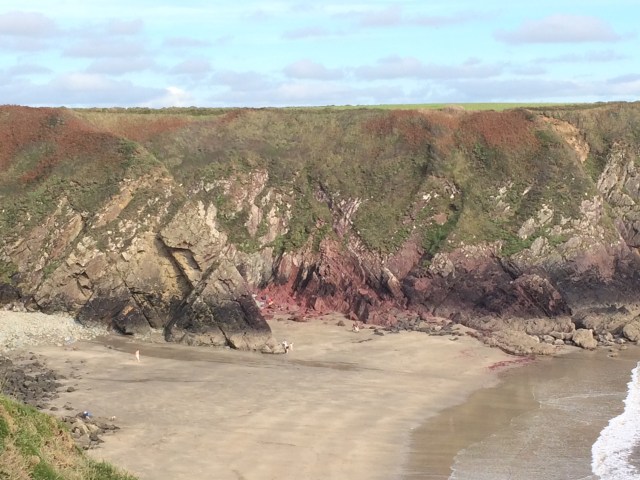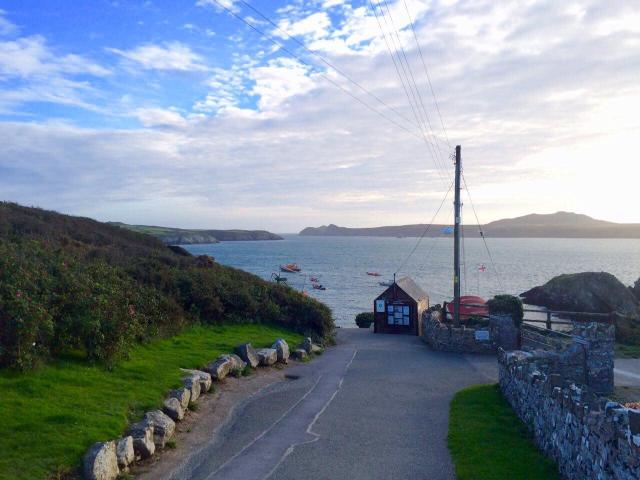
129. Rhoscrowdder – West Angle Bay
Distance: 9.6 miles
Max Altitude: 57 m
Min Altitude: 5 m
Height Gain: 178 m
Height Loss: 169 m
I won’t lie to you, it wasn’t exactly the best start to the day. Due to my trainer-saving detour around the Valero refinery yesterday, I had finished my day on the wrong side of the plant. So I needed to find my way back to the Wales Coast Path in order to get on my way again. Easier said than done though.
I could see it across a couple of fields so off I strode, making a beeline for the path. There was just one problem, well two actually – a huge bramble hedge and a double barbed wire fence. I took my pack off and chucked it over the barbed wire and then climbed over. My jacket got caught and a hole was ripped. Curses! I landed on the other side and prodded the ground with my foot. It was spongy. I was actually in a bramble-covered bog. Great! Three days ago I would have just waded through the ditch, but with my new trainers on that wasn’t even an option. I exhaled, stared at the sky and wondered what to do. There was no choice but to take the long way around. So back over the barbed wire I went, this time snagging my trousers. And back I trudged across the field towards the road again. A whole 3.5km wasted!
Still, I was back on the Wales Coast Path, and leaving the heavy industry behind me.
It was a fairly straightforward path towards Angle, nice and flat and took me through this field of cabbages.
I arrived in Angle to sounds from the Castlemartin firing range booming in the distance. The tide was out, so I began so walk around the headland.
The joy I felt when I got to The Old Point House pub! The even greater joy of seeing the words ‘walker’s lunch’! At spring tides this pub gets cut off from the mainland. I’m sure the people inside really hate it when that happens….(!)
Although I had walked past this pub on a previously, I’d never been inside before. It didn’t disappoint.
As well as the fire, various nick nacks had been encased in the walls.
There were interesting things everywhere, not least this bottle of booze, which had pride of place on the wall. I learnt why.
In 1878, the schooner, Loch Shiel, bound for Adelaide with a cargo of 100% proof whisky and gunpowder, was wrecked just off Thorn Island (which I would arrive at later in the day), near Angle. The Angle lifeboat was launched and the passengers and crew were all rescued. As the ship broke up, her cargo began to float ashore. The locals arrived at the beach to see what they could find and quickly realised what was contained in the wooden cases! In order to avoid Customs officials, many of the bottles were stashed in nearby caves, into alcoves in cottage walls, in attics or boarded up completely. Some lay hidden for decades. There were some fatalities though – three men died, two of them drowned while trying to recover whisky from the sea, the other from alcohol poisoning after drinking the 100% proof booze. Divers are still pulling up bottles to this day and it’s still drinkable. The bottle on the wall is an original recovered from the Loch Shiel.
After deciding that this is one of the finest pubs on the Wales Coast Path so far, I got on my way reluctantly. I will be back to The Old Point House though.
I was pleased to see Stack Rock Fort in its full glory from the other side of the Haven. I continued walking, daydreaming about what it would be like to live there.
Moving through a gate I encountered this little fellow. I’ve never seen a sheep that resembles a teddy bear quite so much.
I heard a loud rumbling in the distance. On my right shoulder was the ferry on its way out of Pembroke Dock towards Ireland.
Another place I’ve previously walked past but never visited is Chapel Bay Fort. This was previously a military fort and is now a museum and cafe.
Built in 1891, it’s part of a series of defences along the Haven, some of which I’ve walked past and blogged about (included Stack Rock Fort!). Last year it was re-opened as a museum and cafe after having been restored.
There were interesting artefacts everywhere. Yet another place to return to.
As I proceeded around the headland I saw my ultimate home, even more so than Stack Rock Fort – Thorn Island, site of the Lock Shiel shipwreck.
This is also one of the former military defences of the area. The fort was built in 1854 with a casemated battery of nine guns. When it was decommissioned after World War Two, it became a hotel, accessible only by boat. It went on sale in 2011 and was snapped up quickly by the current owners. Who could blame them?
With my head filled with daydreams, I proceeded towards the western side of Angle.
I continued around West Angle Bay. My progress was hindered at one point by this friendly wild horse. After some nose petting, he let me pass.
Within a couple of miles, my phone conked out. I think it was the cold. I debated whether to carry on or turn back. I decided to walk the two miles back to Angle rather than proceed. The next stretch was tough and remote and I didn’t want to be caught out without communications so I did the sensible thing (I’m sure my mother reading this will be delighted).
A little disheartened at my retreat, I sat on the shore eating a Welsh cake. My spirits soon lifted as I watched the sun disappear over Pembrokeshire.

































































































































































































































You must be logged in to post a comment.